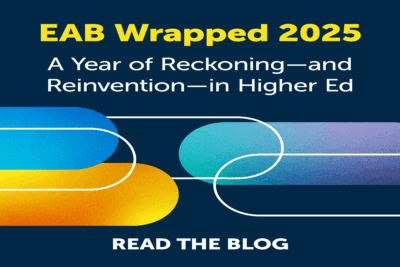Design strategy for continuing and professional education at the University of Texas at Dallas
Lance K. L. Bennett
Associate Director of Assessment and Accreditation, Office of Institutional Success and Decision Support, the University of Texas at Dallas
The views and opinions expressed are those of the author and do not necessarily represent the views or opinions of EAB.
Research from the United States Department of Education shows 1.2 million fewer traditional–aged (18–24) college students in 2022 from 2019. At a time of intensifying pressures in higher education, colleges and universities are actively seeking additional populations to educate, namely adult and professional learners.
The University of Texas at Dallas (UTD) is in a unique position. The institution is experiencing traditional aged enrollment growth in a geographic region with an increased population. According to the U.S. Census, the Dallas–Fort Worth metroplex (DFW) is the number one fastest-growing metro in the country. This report, then, is not in response to a grim institutional situation. Instead, it is a recognition that UTD has an opportunity to better support the DFW region and the State of Texas through continuing and professional education. UTD is one of two University of Texas System institutions without an existing continuing and professional education unit.
Moreover, the DFW region and the State of Texas have a growing need better educate its workforce. The Texas Higher Education Coordinating Board’s (THECB) agenda of Building a Talent Strong Texas desires that 60% of Texans ages 25–64 will receive a degree, certificate, or other postsecondary credential of value by 2030. Fortunately, the DFW region is economically strong with several small businesses, corporations, and home to 24 Fortune 500 companies. THECB’s age range is an opportunity for UTD—to meet this mandate through continuing and professional education.
Strategic Recommendations for UTD
- Learn about the Learner: UTD should invest time in learning about the needs of the individual learner—both skill needs (professional/personal aspirations) and their industry needs (universal/nuanced).
- Action Step: Build UTD’s online education presence. For many micro–credentials, it is necessary to have on–demand courses and materials. Other credentials may have a dedicated sequence and amount of time. This depends on the skills required for completion and the student learning outcomes needed for each credential.
-
Interested in the Rising Higher Education Leaders Fellowship?
Learn more about the program and future cohorts.
- Form a Lifelong Relationship with Learners: Attracting new learners will require the institution to adopt a model of relationship and move away from student learning as a transaction.
- Action Step: After learners complete a course or credential of value, UTD should have constant engagement that follows learners through their careers to build lifelong relationships.
The Rising Higher Education Leaders Fellowship has been a wonderful learning experience. I thank the session facilitators and experts for providing additional guidance on this project. Likewise, I was partnered with capstone buddies, Barbara Andrew from William Patterson University and Daisy Sherry from Lewis University. Both were excellent resources in the realm of continuing and professional education.
More Blogs

What our global partners asked us most in 2025

Is your yield rate okay?
